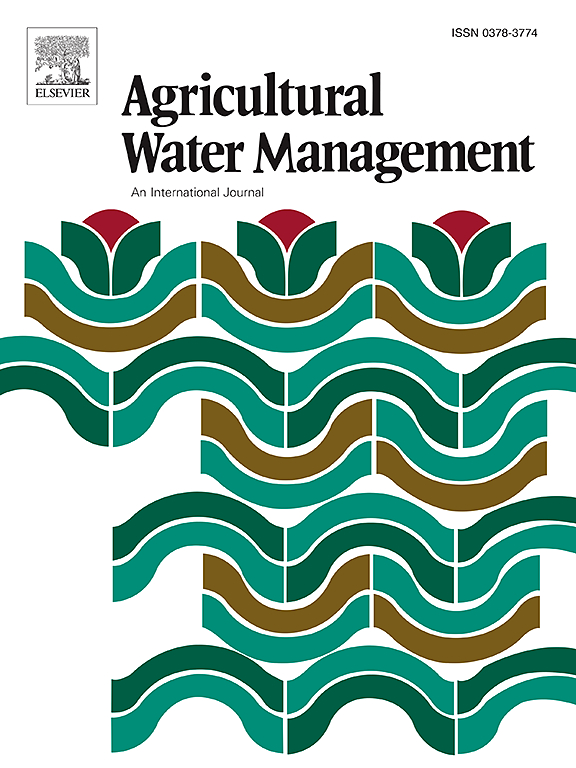节水灌溉配施氮斜沸石通过改善水稻根系特征提高养分产量和水分生产力:一项联合PCA-SEM分析
IF 5.9
1区 农林科学
Q1 AGRONOMY
引用次数: 0
摘要
氮负载的斜沸石以其高保水和营养补充特性而闻名,这有利于作物生长。然而,其与节水灌溉制度对氮矿化、根系特征和养分产量的综合影响,特别是其调控途径仍未得到充分探讨。这项为期两年的分块试验评估了两种灌溉方式(ICF:连续漫灌;IAWD:干湿交替灌溉)和两种氮含量的斜发沸石(NZ0:无氮含量的斜发沸石;NZ10: 10 t·ha-1)对根系特征、矿化氮、养分产量和水分生产力的影响。采用主成分分析(PCA)和结构方程模型(SEM)分析了各因素之间的相互作用。IAWDNZ10处理节水潜力最大,灌溉面积比ICFNZ0增加0.29倍。在IAWD下,载氮斜发沸石使根表面积增加12.6 %,平均根直径增加14.2 %,根体积增加13.8 %。此外,IAWD使矿化氮增加了22.4% %,而载氮的斜沸石进一步提高了34.7% %。根系特征(r = 0.78)是载氮斜沸石对蛋白质(r = 0.64)和直链淀粉营养产量(r = 0.68)影响的关键介质。水分利用通过白垩米率间接影响蛋白质(r = -0.93)和直链淀粉营养水分生产力(r =-0.67)(r =0.90)。综上所述,将载氮斜沸石与IAWD相结合,不仅改善了水稻根系特征和矿化N,而且显著提高了养分产量和水分生产力。这些发现强调了氮负载斜沸石作为可持续农业实践关键组成部分的潜力,为优化资源利用、减少环境影响和提高水资源有限地区的作物生产力提供了一条途径。本文章由计算机程序翻译,如有差异,请以英文原文为准。
Water–saving irrigation combined with N–loaded clinoptilolite enhances nutrient yield, and water productivity by improving rice root characteristics: A combined PCA–SEM analysis
Nitrogen (N) –loaded clinoptilolite is renowned for its high–water retention and nutrient supplementation properties, which benefit crop growth. However, its combined effects with water–saving irrigation regime on N mineralization, root system characteristics, and nutrient yield, particularly their regulatory pathways, remain underexplored. This two–year split–plot experiment evaluated the impact of two irrigation regimes (ICF: continuous flooding irrigation; IAWD: alternate wet–dry irrigation) and two rates of N–loaded clinoptilolite (NZ0: no N–loaded clinoptilolite; NZ10: 10 t·ha–1) on root characteristics, mineralized N, nutrient yield, and water productivity. We employed principal component analysis (PCA) and structural equation modeling (SEM) to analyze the interactions among the factors. The IAWDNZ10 treatment showed the greatest water–saving potential, increasing the irrigated area by 0.29–fold compared to ICFNZ0. N–loaded clinoptilolite under IAWD increased root surface area by 12.6 %, average root diameter by 14.2 %, and root volume by 13.8 %. Additionally, IAWD increased mineralized N by 22.4 %, while N–loaded clinoptilolite further boosted it by 34.7 %. Root characteristics (r = 0.78) were crucial mediators in the effect of N–loaded clinoptilolite on protein (r = 0.64) and amylose nutritional yield (r = 0.68). Water usage influenced protein (r = -0.93) and amylose nutritional water productivity (r =-0.67) indirectly via chalky rice rate (r =0.90). In summary, integrating N–loaded clinoptilolite with the IAWD regime not only enhanced rice root characteristics and mineralized N but also led to substantial increases in nutrient yield and water productivity. These findings underscore the potential for N–loaded clinoptilolite to be adopted as a key component in sustainable agricultural practices, offering a pathway to optimize resource use, reduce environmental impact, and improve crop productivity in water–limited regions.
求助全文
通过发布文献求助,成功后即可免费获取论文全文。
去求助
来源期刊

Agricultural Water Management
农林科学-农艺学
CiteScore
12.10
自引率
14.90%
发文量
648
审稿时长
4.9 months
期刊介绍:
Agricultural Water Management publishes papers of international significance relating to the science, economics, and policy of agricultural water management. In all cases, manuscripts must address implications and provide insight regarding agricultural water management.
 求助内容:
求助内容: 应助结果提醒方式:
应助结果提醒方式:


